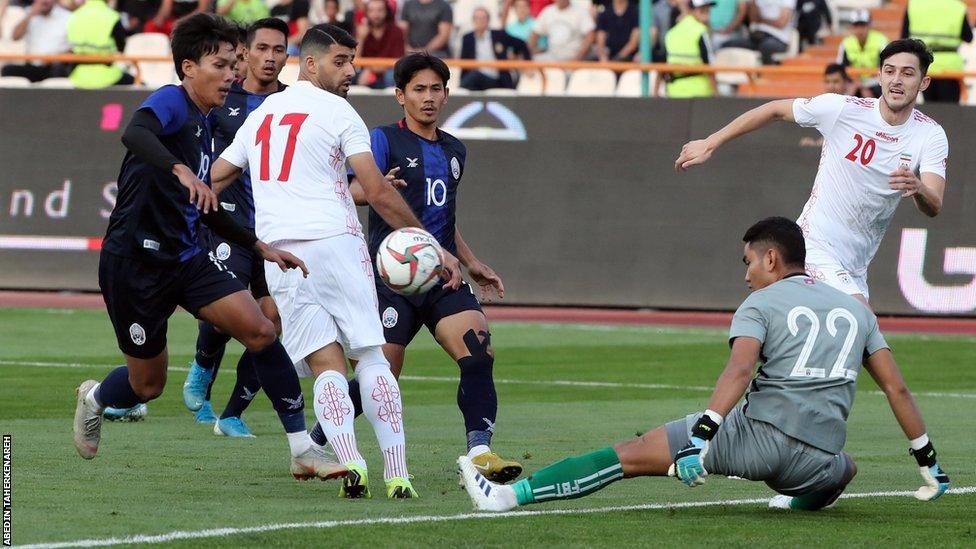Iran 14-0 Cambodia: Women attend Tehran match for first time in 40 years
- Published

Iran's female fans certainly had a lot to cheer as they saw their team for real for the first time
Iran thrashed Cambodia 14-0 in their 2022 World Cup qualifier on the day women were officially allowed into the ground to watch the match for the first time in 40 years.
Four goals from Karim Ansarifard, a hat-trick from Sardar Azmoun and two each from Mehdi Taremi and Mohammad Mohebi did most of the damage to the Cambodians, though the result will much less historically significant than the attendance.
While a handful of women had watched a men's game before, they had been pre-selected by authorities; this was the first time women had been allowed to buy tickets on general sale, although they were restricted to their own section.
Around 3,500 tickets were sold for the special women's section at the game, which was full a whole hour before the match started - with the rest of the stadium virtually empty.
Allow X content?
This article contains content provided by X. We ask for your permission before anything is loaded, as they may be using cookies and other technologies. You may want to read X’s cookie policy, external and privacy policy, external before accepting. To view this content choose ‘accept and continue’.
In the stadium: Nazanin, female Iran fan
"When we arrived, women and girls were celebrating already and cheering for the national team.
"The excitement was a rush - to be let into the stadium for the first time.
"They treated us very respectfully at the entrance to the ground, from where we took buses to get to stadium itself.
"We were very, very happy and excited to see the pitch, for real, for the first time in our lives.
"Inside the stadium I couldn't hear myself talk.
"There were supervisors from Fifa who arrived to observe and check the behaviour of the Iranian authorities.
"Women were celebrating with an hour to go to kick off - the men had not even arrived."
Pressure
The pressure on Iran to allow women to watch football matches without restriction had already been increasing after Fifa brought in statutes that banned countries from discriminating against fans on the basis of gender, but the death of Sahar Khodayari - known as the "blue girl" - after her arrest while trying to watch a domestic football game made Fifa insist they would "stand firm" over women being let in.
Nevertheless, Amnesty International called the 3,500 figure a "token number" and a "publicity stunt" given the stadium has a capacity of 78,000.
Given the media interest in the story, many of the female fans were interviewed by journalists on their way in - including one girl who was asked to name the starting 11 of Persepolis FC, which she did with ease.
However, female photographers were not allowed in.
There was also a problem that the toilet facilities were very scant, given the Azadi Stadium, built in 1971, had not expected to have to accommodate women.

Mehdi Tarem scored Iran's fourth - after just 20 minutes
Analysis: Feranak Amidi, Women's Affairs Correspondent, BBC Persian
It is a significant moment - unfortunately, it's also a bittersweet one.
It took the life of a young woman for international pressure to mount up enough to get Iranian authorities to allow women inside the stadiums.
It still was not on equal grounds - women were allocated very limited tickets for the game. The stadium was empty outside of the women's section.
Women who weren't able to buy tickets online got to the stadium and weren't allowed to get them there.
We have to ask why it got to the point that a woman had to set herself on fire to put enough pressure on Iran for it to change its strategy.
Women have been fighting for this right for the last four decades. But it was not on equal grounds - even professional female photographers were not allowed in to take photos of the match.
Allow X content?
This article contains content provided by X. We ask for your permission before anything is loaded, as they may be using cookies and other technologies. You may want to read X’s cookie policy, external and privacy policy, external before accepting. To view this content choose ‘accept and continue’.